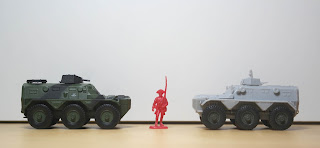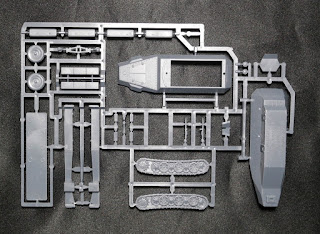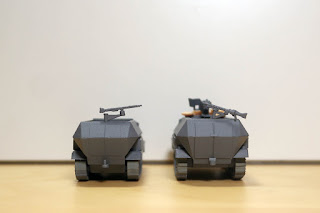The Alvis FV603 Saracen was designed as a post-war replacement for the AEC armored car. The Saracen was rushed into production in 1952 for use during the
Malayan Emergency. In subsequent years it played a similar role in
apartheid era South Africa and
Northern Ireland.
The Royal Hong Kong Police introduced them to their Police Tactical Unit (PTU) in 1970 after the
1967 Hong Kong Riots (六七暴動), where it was used until 1988 when it was replaced by the
Saxon.
The most common diecast models of the Saracen are the venerable Matchbox/Lesney model in 1/86(?) and the Dinky model in 1/60(?) scales.
The Dinky model is of note because a version was produced in the livery from the
Mission Highly Improbable episode of the TV show
The Avengers.
 |
| That's not 1/72! |
In the 1/72 world, diecast Saracen models have recently been produced by Tiny City. As a Hong Kong based company, it was obligatory for them to release several PTU versions in addition to a single British Army version.
 |
| PTU 5 and PTU 4 |
 |
| PTU 12 and PTU 5 |
 |
| PTU 4 and British Army |
 |
| British Army and PTU 12 |
PTU 12 came with some red cross stickers for the turret which I did not use. In addition, it has a flag, but there is no way to mount it on the hull (I just used some Elmers Tac to stick it on the side of the hull for pictures).
I bought a couple of extra British Army versions because I wanted to repaint them in a uniform Deep Bronze Green or NATO Green, but I'm not sure how to disassemble the models since there are no obvious screws or rivets like in typical diecast cars, so the project will have to wait.
As for plastic models, JB Models made a 1/76 version that is now sold by Airfix, but it is only recently that Ace has released a version in 1/72 scale.
The kit instructions are overly busy, and the numbering is a tad messed up, but it can eventually be figured out if you look at them hard enough. I ended up not following the exact order of assembly as written in the instructions.
The most confusing part is the suspension and lower hull, with many tiny and complex parts.
It is important to scrape off all the seam lines on parts C18 and C19. If you look closely at the parts, you should notice some divots that may need to be deepened with a rat-tail file so that parts C04 can fit between the struts.
Place parts
C18 and
C19 through part
C23, then fit C23 to the side of the hull and apply liquid cement to all the parts.
Next, glue
C17 and
A10 in place, followed by parts
C14.
After all that, glue parts
C08 and
C09 in place. The instructions don't really give a good indication of where they are supposed to be glued, or how they should be oriented.
Finally, glue parts
C02 and
C03 onto
C01 and then glue the assembly to the hull. The ends of C02 and C03 should be glued to the neighboring parts C14 at that point as well.
Of course the most frustrating part of spending all the time building the complicated suspension is that it will hardly be visible after the wheels are attached.
Another place that needs a little clarification is when attaching A08/A09 to A06. It is easier to glue the ends of the vents in place
before gluing A06 to the hull.
The hull was partially filled with pieces of sprue to give it a little bit of heft (similar to the solid feel of a PSC kit).
The parts of the turret are mislabelled, and the tabs of the underside need to be carved out, since it seems the designers forgot how they are supposed to work.
I thought that the Ace kit would have been a nightmare after working on so many quick build kits lately, but I did not find the kit to be difficult to build (though I think it was needlessly complex).
Another bright spot was that I only lost one of the dozen individual lift rings that need to be attached to the hull. Luckily the kit had two extras, so no additional scratch building was necessary.
All that needs to be done is to attach the wheels, add some final parts (tools, headlights, machine guns, commander figure), and paint the model.
The near final product is actually about 2mm shorter in length, and 1mm shorter in width and height than the Tiny Saracen. The turret also looks significantly smaller.
Now I'm a bit curious as to how the Ace model compares in size to the Airfix model.






































































